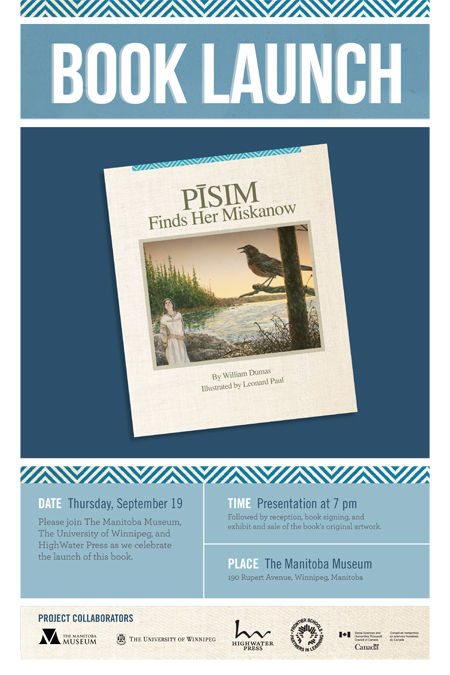“This enchanting book deserves a place in every school in the province. It is a beautiful rendition of historical fiction that can give all young people a collective understanding of the power of our history in shaping who we are.” Dr. Lloyd Axworthy, UWinnipeg President and Vice-Chancellor.
In 1993, the remains of a twenty-five year old Cree woman, who lived 350 years ago, were discovered at South Indian Lake in northern Manitoba.
Now, twenty years after this extraordinary archeological discovery, the woman’s story has been imagined as a children’s book. The story covers a week in the life of Pisim, a young Cree woman, who lived in the mid 1600s. In the book, created by renowned storyteller William Dumas and illustrated by Leonard Paul, Pisim comes to terms with her miskanow, or her life’s journey.
The beautifully illustrated children’s book, written at a grade five level, has been a seven year labour of love for its creators, which include Dumas and Paul, as well as representatives of The Manitoba Museum, the University of Winnipeg and members of the aboriginal community.
“The dream never died,” says writer William Dumas. “It started in 1993 and it never ended. It just took a little bit of time to come through,” he says with a chuckle.
“When her body was discovered, I was working in Nelson Lake,” says Kevin Brownlee, Curator of Archaelogy at The Manitoba Museum. “My boss went up to investigate the found human remains. There was a burial and it looked really important and significant. He knew we had to go back the next year and do a proper recovery. I became one of the first people in 350 years to see her tools.”
This remarkable discovery was the impetus for Brownlee’s 1999 publication, Kayasochi Kikawenow, in which he first wrote about the Cree woman. She would very likely have been part of the last generation of native people would have never had any contact with Europeans.
“The whole point of the book is to show the strength of the past and how it strengthens today’s community and helps us move into the future,” says William Dumas, author of Pisem Finds Her Miskanow. “It’s to give youth a sense of identity. People need to know who they are. Ensuring the accuracy of the book demonstrates the importance of Cree culture and heritage to our youth.”
“The elders said everything happens for a reason,” says Brownlee. “This woman is showing herself to educate the youth because they’re starting to lose touch with their culture and history.”
The story is brought to life by the rich imagery of Leonard Paul, and is a primer on Cree culture and history. The sidebars on Cree language and culture, archaeology and history, maps, songs, and more illuminate a healthy and strong culture.
Pisim lived at an interesting time of immense change. “Things were about to change forever,” says Brownlee. “At that time, there was absolutely nothing being traded off of Hudson Bay, it was all coming from the Great Lakes. She likely never saw a European. She would have heard stories about them, but didn’t see one. That whole change gave this story a universal appeal.”
“There was such a beautiful array of tools found with her body,” adds Brownlee, of what helped the team imagine Pisim’s compelling life. “The red pipestone beads on her necklace were the furthest north ever found. She had made beads from pin cherries and attached them to her hood. She had a stone woodworking tool and hide scraping tool.”
The search for absolute authenticity drove the book’s creators and is partly why the process was so demanding. “We were so meticulous about being accurate on what we were representing,” says Brownlee. “The South Indian Lake area had undergone significant flooding since the 1970s. What did the scenery look like? What did it look like when it was calm? 99.9% of the people will have no idea this is correct. However, the kids of this area will know that this is their home.”
Another of the instrumental contributors to this book was Dr. Mavis Reimer. Reimer is Canada Research Chair in Young People’s Texts and Cultures, Professor of English, and Dean of Graduate Studies at the University of Winnipeg, where she founded the Centre for Research in Young People’s Texts and Cultures (CRYTC).
The project of developing the story and collecting the additional information on Cree language and culture, archaeology and history, maps, and songs included in the book was supervised at CRYTC.
Dumas went to Reimer and proposed that they collaborate on the project. “I did not know at that time how persuasive William Dumas can be nor did I know how compelling was the story that he had to tell,” says Reimer.
Reimer is not in the business of publishing children’s books. Her work is to study them, but this project proved too good to resist.
“The moment in the book that makes my skin prickle every time I read it is when Pisim’s grandmother says to her, “Come, my child, come and stand beside your responsibility.” Reimer says her definition of miskanow has broadened as she has worked on the book. She initially understood it to mean career path, but over time, she came to see it more as “a pathway that is discerned for you by the people with whom you are in community.”
For Brownlee, who hopes this book will be the first of a series of six books, is as immensely proud of the final result as he is of the process. “I truly believe that I was part of the group selected by this young girl to tell her story. I felt we had to be respectful in telling her story.”
by Greg Klassen, Manitoba Museum
Pīsim Finds Her Miskanow Book Launch
Thursday, September 19 at 7:00pm
Manitoba Museum
190 Rupert Avenue





